Process for the manufacture of 1,2-dichloroethane
a technology of 1,2-dichloroethane and process, which is applied in the field of process for the manufacture of 1,2-dichloroethane, can solve the problems of uneconomic conversion of hydrogen present, inability to use ethylene obtained, and poisoning of catalysts, and achieves the effect of reducing costs and improving purity
- Summary
- Abstract
- Description
- Claims
- Application Information
AI Technical Summary
Benefits of technology
Problems solved by technology
Method used
Image
Examples
first embodiment
[0022]FIG. 1 illustrates the process for the manufacture of DCE according to the invention; and
second embodiment
[0023]FIG. 2 illustrates the process for the manufacture of DCE according to the invention.
DETAILED DESCRIPTION OF PREFERRED EMBODIMENTS
[0024]According to step a) of the process according to the invention, the stream of ethane is subjected to a catalytic oxydehydrogenation producing a gas mixture containing ethylene, unconverted ethane, water and secondary constituents.
[0025]The stream of ethane subjected to the catalytic oxydehydrogenation may or may not be chemically pure. The stream of ethane used may contain up to 70 vol % of other gases such as methane, hydrogen, ethylene, oxygen, nitrogen and carbon oxides.
[0026]The stream of ethane used advantageously contains at least 80 vol %, preferably at least 90 vol %, particularly preferably at least 95 vol % and more particularly preferably at least 98 vol % of ethane. If necessary, the ethane may be separated from the secondary compounds having a higher boiling point in any known device, for example by absorption, extraction, diffusi...
PUM
| Property | Measurement | Unit |
|---|---|---|
| vol % | aaaaa | aaaaa |
| vol % | aaaaa | aaaaa |
| temperature | aaaaa | aaaaa |
Abstract
Description
Claims
Application Information
 Login to View More
Login to View More - R&D
- Intellectual Property
- Life Sciences
- Materials
- Tech Scout
- Unparalleled Data Quality
- Higher Quality Content
- 60% Fewer Hallucinations
Browse by: Latest US Patents, China's latest patents, Technical Efficacy Thesaurus, Application Domain, Technology Topic, Popular Technical Reports.
© 2025 PatSnap. All rights reserved.Legal|Privacy policy|Modern Slavery Act Transparency Statement|Sitemap|About US| Contact US: help@patsnap.com


